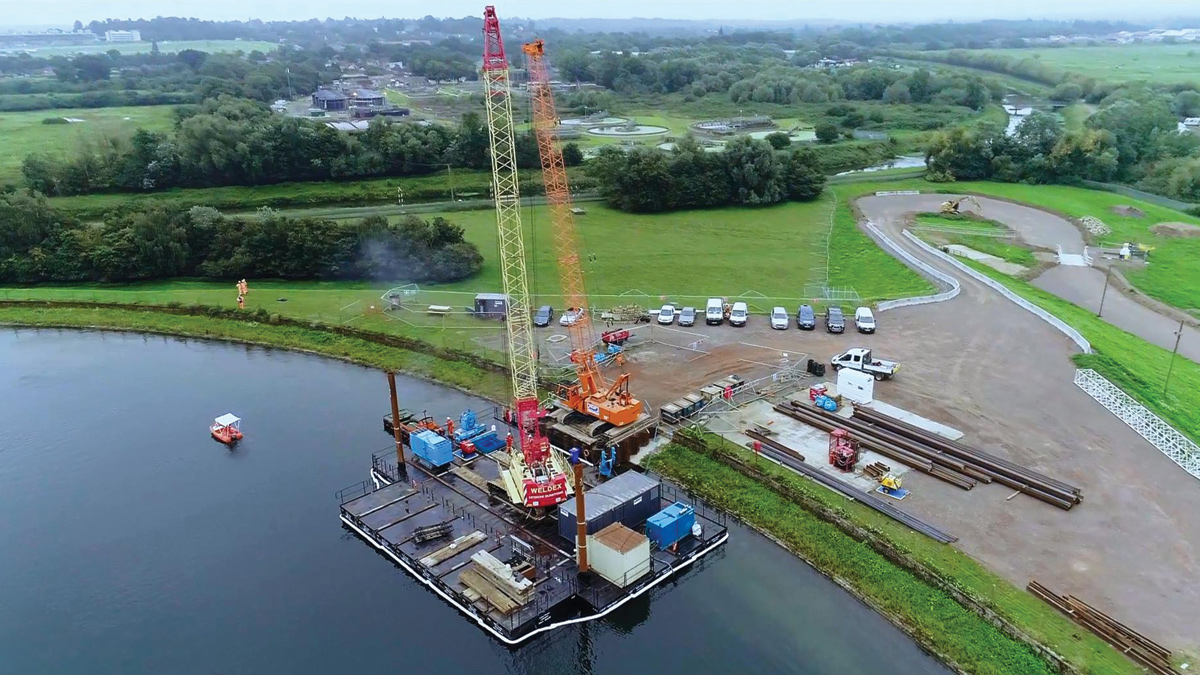Island Barn Reservoir Remedial Works (2018)

Loading of piles at new jetty - Courtesy of eight2O
Island Barn Reservoir is located in West Molesey near Hampton Court on the Surrey/London border. The reservoir is a non-impounding reservoir and is retained by an earth fill embankment with puddle clay core approximately 10.8m high and 2,700m long. The reservoir has a stated capacity of 4,191,000m3 and a surface area of 489,700m2, when full to its top water level of 17.59m AOD. For a number of years signs of leakages were observed. Leaks were suspected, but there was no direct information about the depth and location. Hence there would be high degree of uncertainty that any solution was dealing with the problem and not making it worse. There were operational restrictions on the reservoir which was run at a lower top water level and with enhanced surveillance (visual and surveyed) to pick up any movement/change in conditions. Within this project the problematic areas were identified and a combination of silent/pressed piling, from plant mounted on the water was used. The project was delivered by the eight2O joint venture, working for Thames Water.

Surveys and coverage – Courtesy of Willowstick Surveysys
Introduction
For several years there have been signs of leakage through the embankment of Island Barn Reservoir. There were visible wet patches at the bottom of the embankment and restrictions operated on the reservoir.
A Willowstick survey (geophysical survey technology that scans electrical current flows between electrodes to sense water flow paths) was undertaken in 2015. It was found that were three defined areas of seepage below the clay core that forms the waterproofing core of the embankment.
The solution
The number of options were considered as per the following table:

Island Barn Reservoir options

(left) Leakage at toe and (right) new jetty in construction – Courtesy of eight2O
Do nothing was not an option as there was an expectation that the situation would deteriorate and a failure of the embankment was major risk that Thames Water needed to mitigate under law. The solution chosen was to drive a series of interlocking sheet piles down through the clay core and link up to the underlying competent London Clay.
The particular method chosen was GIKEN (silent piling) where piles are pressed in. Traditional methods of hammering or vibrating piles into place would have risked damaging the embankment.
It was also planned that the piling equipment would be mounted on a pontoon system placed within the reservoir. This saved having to do a large strip of the embankment to enable heavy equipment to safely bear down.

Pile being pressed – Courtesy of eight2O
Project challenges
There were three areas where the access ways were traversing vulnerable mains. In particular there were some shallow potable water mains that had known leakage and a history of bursts. In one area a temporary bridge (27m span) was placed between concrete foundations that were founded onto competent ground on either side of the services.
To get heavy construction plant down from the crest/wave wall, to the water, special arrangements were required. A piled jetty was constructed to the south west corner of the reservoir at a level that would allow plant to track down and onto pontoons.

Temporary access bridge being assembled – Courtesy of eight2O
Project progress
Enabling works (roads and service protection) started in March 2017 and the jetty was constructed in July 2017. Piling work was successfully undertaken between August and October 2017. There were 386 (No.) piles, 18.5m long and 600mm wide as part of the main piling length. From these, 3 (No.) were water-jetted to help the piles penetrate far enough into the underlying clay and 3 (No.) were cut as they had penetrated the clay but were unable to be fully driven.

Long view of piling rig – Courtesy of eight2O
Summary/conclusion
The project started in March 2017 and was fully completed in November. Significant budget and time savings were possible by using a number of established technologies and combining them in an innovative fashion. There was minimal impact and loss of storage of the operational asset during construction.
This general system of work will be adopted where possible on the remaining portfolio of reservoir remediation schemes.



